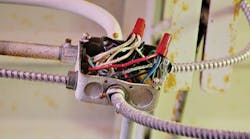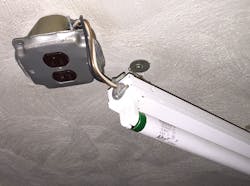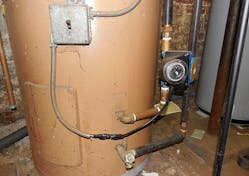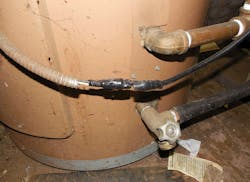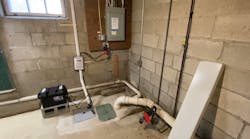All references are based on the 2014 edition of the NEC.
A Complete Garage Sale of Concerns
Whatever materials and equipment he had laying around in his garage in order to “just get the job done.” In doing so, he violated several Code rules and created some safety concerns.
Section 300.3(A) permits single conductors to be used only when they are installed in or part of a Chapter 3 wiring method such as NM cable, electrical metallic tubing (EMT), or flexible metal conduit (FMC), among others. The connectors used for these single conductors appear to be of the type designed to be used with NM cable. This installer used them in a manner that would violate Sec. 300.15, since they are not designed and listed for use with single conductors. With no cable jacket or raceway to protect these wires, they could be pinched or damaged on the metal edges of the connectors, which could create a short circuit or ground fault, resulting in arcs and sparks.
Another visible problem is the use of a 4-in.-square cover on a 4-in.-round box. This creates a violation of Sec. 110.3(B) and also leaves me wondering about all of the other violations that just may not be visible in this photo. It’s a scary thought.
A Variety of Violations
The box is overcrowded. The cables and connectors are loose. The box isn’t properly supported. Green wires are being used as “hot” conductors, and who knows what other problems may not be visible in this photo.
The overcrowded box is a violation of Sec. 314.16, which requires boxes and conduit bodies to provide enough free space for all of the conductors. The minimum box volume must comply with the box volume and box fill calculations outlined in Secs. 314.16(A) and (B).
The loose MC cables are a violation of Sec. 300.10, since they do not establish the required electrical continuity and conductivity for proper grounding and bonding. This lack of bonding and grounding also creates a violation of Sec. 250.4(A)(5).
The lack of proper support for the box is a violation of Sec. 314.23, which allows many options in sections (A) through (H) for supporting boxes — none of which includes using EMT or MC cables for support of a box.
If you look closely, you might be able to see that one of the green wires is taped blue, and is spliced in with the blue, black, and red conductors. Using a conductor with green insulation as an ungrounded conductor is a violation of Sec. 250.119.
A Shining Example of What Not to Do
I found this mess while visiting a restaurant on a family vacation. I noticed an NM cable coming out of the outside wall of the restaurant. So I followed it until I saw where it connected to this junction box.
Using NM cable outdoors (i.e., a wet location) is a violation of Sec. 334.12(B)(4). Because this cable is also exposed to the sun, it’s a violation of Sec. 310.10. Neither the cable jacket nor the conductors are listed as being sunlight-resistant. This exposure has deteriorated the cable jacket beyond repair, and the conductors are now directly exposed to the elements. This damage can greatly increase the shock and fire hazard at this specific location.
You may also notice that the box is only supported by one EMT, which is installed in the bottom of the box. Using EMT to support a box in this manner is a violation of Sec. 358.12(5).
In addition, the set-screw type of EMT connectors and couplings used by the installer is a violation of Secs. 358.42 and 314.15, since these fittings are not specifically listed for use in wet locations.
Possibly a Plumber’s Problem?
This may be a shot in the dark, but I’m guessing that a plumber or handyman replaced this circulator pump. As you can clearly see, he simply spliced the pump wires directly on the conductors, extending out of the flexible metal conduit (FMC) instead of having a qualified electrician do it the right way by installing these splices in a box.
Section 300.15 requires a box to be installed for conductor splice points when the wiring method used is conduit or cables. Splicing wires in free air and wrapping them in tape simply does not provide the same level of protection that a box could provide for the splices.
I’m also concerned about the grounding means for this pump. There appears to be no equipment ground wire installed with the circuit wires in the FMC. Section 250.118(5) allows FMC to be used as the equipment grounding conductor (EGC) only for a 20A or less circuit when the conduit is terminated with listed fittings and the FMC is no longer than 6 ft. Sections 250.118(5) and 348.60 both require an EGC to be installed when flexibility is needed for minimizing vibrations from equipment such as motors.
